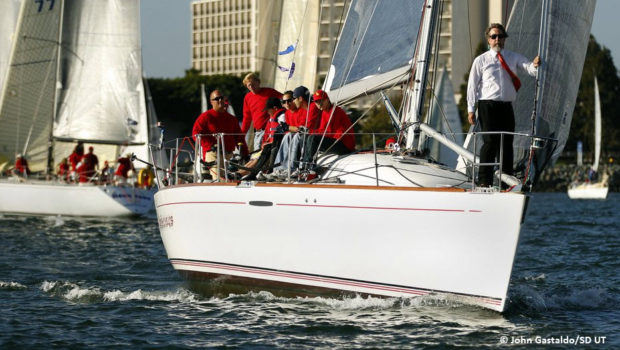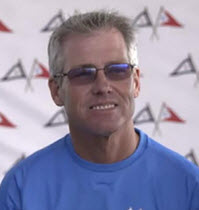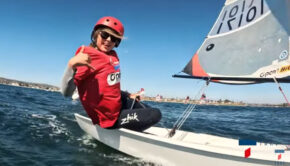Getting Back to the Love of Sailing
Published on February 13th, 2017
Jon Rogers has that rare background of being both sailing champion and educator. From standing atop a World Championship podium, to kneeling with the greenest sailor, Jon has a valued perspective that he shares in this report.
I had the recent opportunity to coach the NORTH U Clinic at the newly established St Thomas Sailing Center at St Thomas Yacht Club. It was an awesome experience that I highly recommend for any sailor who wants to improve racing and spinnaker skills.
I also had the pleasure of discussing a multitude of topics about sailing with many STYC members. I found this group to really have their “eye on the ball” with their emphasis on improving access to boating and focusing on the love of being outdoors sailing.
Among the discussion group was the esteemed Bill Canfield who shared how his son Taylor and friends would regularly sail their Opti’s to St John for an ice cream cone. Round trip was 3+ hours, sometimes longer. Every point of sail, every wind condition, every wave condition, and friends (and ice cream). What an education!
Let’s talk about love.
One of the areas we discussed was how the love for sailing was missing. We agreed the sport is stable when we are sailing just for the sake of sailing and racing hard but not entering into an arms race. The increased intensity we are witnessing makes the “tail-enders”, “mid-packers” and sometimes women not enjoy the sport. We need all of those demographics for the sport to have larger and healthier amateur fleets.
We also wondered about the love from clubs. There are lots of clubs that do a great job of being welcoming and inclusive especially in junior programs, but tradition, fear of liability, budget committees, and food service have shown that maybe sailing isn’t the most important thing. I question if the club’s biggest liability isn’t the 8 year old Opti sailor on the water for 4 hours a day but rather folks driving after 2++ drinks in the club bar.
Sometimes I ponder whether some people really love sailing or do they love the competition. I suspect it’s a little of both with variable percentages. I question this love element when youth coaches are towing in the kids after racing despite perfect wind and plenty of daylight. Are they in a hurry to the dock to get on their phones?
My dad jokingly taught me “win or don’t come in”, which was to mean the best time to practice and improve was in the afternoon, especially after racing while lessons learned were most fresh. The Brazilian Snipe fleet taught me this as I watched them sail “full hike” on the way home after three brutal races.
Another instance I question is when the top sailors, after a poor race, complain how the race should have never been run due drifter winds or a skewed course. Do they love sailing or the chance for a trophy? For me, knowing others have their podium or near podium moments is rewarding. Empathy for those nearer the back is golden, actually.
A few ideas, comments, and suggestions.
#1 – Visit St Thomas Yacht Club. This club is going in the right direction. They have a cool IC24 fleet (deck modified J/24s), a beach front stuffed with small boats that can get out quick, a marketing plan to the island and beyond to get new sailors and members, hosting clinics like North U and good regattas to create excitement.
They also made the smart decision to hire Dave Franzel to run their Sailing Center. Dave is the former Owner/Manager of the very successful Boston Sailing Center and a great sailor/instructor/coach. Dave is the type of experienced sailor that our Clubs need to hire.
#2 – Hire more experienced instructors/coaches. The best coaches I know are 30 and older and have vast experience in all forms of boats and situations such as championship races, storms, danger, response to adversity, etc. This knowledge can then filter down in the shortest of time to a kid who taps into it by paying attention.
Sailing clubs should have professional coaches in the same way as golf and tennis clubs with a model for private lessons to help them earn a more live-able wage. I like how we tap into high school and college sailors to coach many of our kids but experience “doesn’t grow on trees” and some young coaches spend too much time blowing whistles and running race starts.
#3 Define Adventure sailing. Fun sailing is reaching in a Laser (or other boat) and ramping up right behind a ferry boat or tug boat and surfing. Fun sailing is flying a spinnaker, trapezing, on a reach in “send it” mode. Fun sailing is leaning to leeward on a Hobie Cat to try to fly the windward hull. This kind of activity is both fun but also teaches sailing skills.
I am worry that Adventure sailing is often a sail to a beach/park for picnics and play. Sailing to the park is fun but not teaching much awareness (the most fundamental skill) when most lessons include building sand castles. My suggestion is that coaches/coordinators/parents/ others share an example of their Adventure Sailing Curriculum to Scuttlebutt. We need more ideas in our programs.
#4 Leave the coach at home. We need to have kids (and adult racers should do this too) leave the coach out of it once in a while. For every third or fourth regatta, sailors need to go support the fundamental foundation of the sport and the rule book and exert individual effort. There are growing examples of excessive assistance at regattas. I suggest having some of the coaches act as safety boats yet only talk to the sailors at the end of racing for very short time on shore. Or just hire someone to make sure the team is safe but allow the kids to support and ‘coach’ each other.
Parents may not realize it but “hardwiring” a child to think their success is tied to the coach or team they are on, or the equipment they have, can be counterproductive in life. Don’t get me wrong – I am a big coach supporter as I regularly see dramatic improvements in sailor’s performances on day 2 and 3 in all facets after strong input. I just suggest more emphasis on self-reliance
Kids should take the drills and techniques the coaches teach and go out together and master them as best as possible before moving on to what is always bigger but maybe not better things. It’s by design that the best coaches are always teaching drills that sailors can do on their own.
#5 Harness the parents energy. If we draw lines in the parking lot to keep parents out, we fail to recognize that parents are crucial to youth sports. On the other hand, if we don’t have strong leadership some parents make it so people want to draw parent boundary lines. My suggestion is to create a list of parent activities and not everyone will be able to do them.
Parent activities should include: Tow trailers, thank and tip the coaches, communicate face to face with program employees, thank you letters for the junior program/team, fundraise, make donations that pay for the most awesome coaches to be teaching sailing and not pushing competition too quickly to the newest sailors. Be the “recognize everyone who supports all the kids” person, and don’t be the person sending angry emails.
#6 Share your thoughts. Send a Scuttlebutt an email on what you think parents can do to support sailing and what your club does when you have that parent who is just too involved, destructive to the team and/or role modeling the wrong qualities in the parking lot. We all can benefit from guidance.
Jon Rogers is Head Coach at Coronado Yacht Club in San Diego and is a World, North American, National, and Midwinter Champion in J/22, Snipe, Thistle, and Santana 20 classes. Jon was 29er Southern California Coordinator from 1999 to 2006 and frequently assists US Sailing and NORTH U programs. In 2016, Jon worked with Degan Media as commentator for ICSA College Women’s and Coed Nationals in San Diego, CA and Resolute Cup in Newport, RI.










 We’ll keep your information safe.
We’ll keep your information safe.